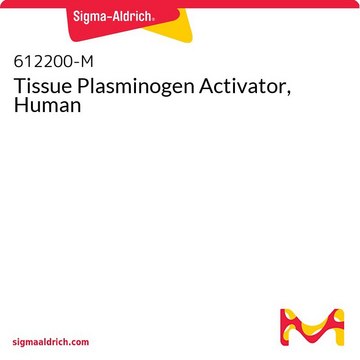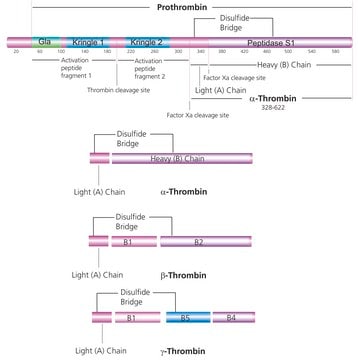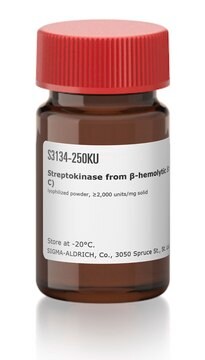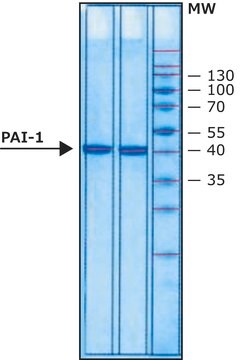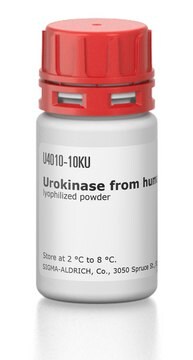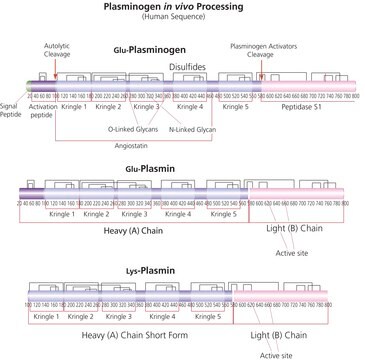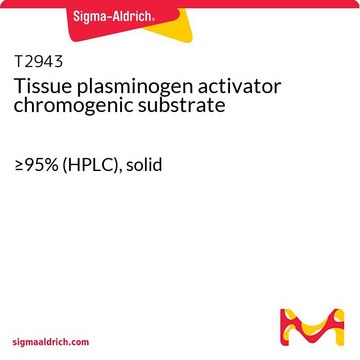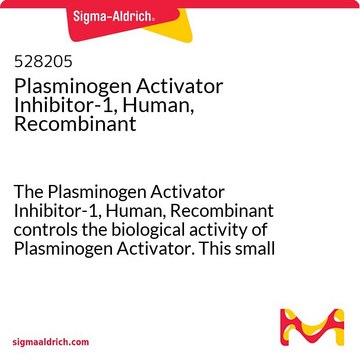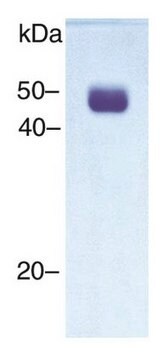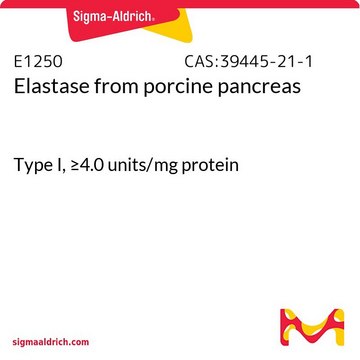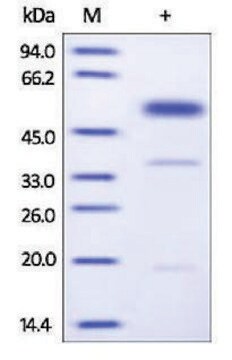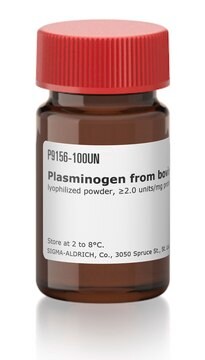Wszystkie zdjęcia(1)
Kluczowe dokumenty
T0831
Tissue plasminogen activator human
Synonim(y):
tPA
Zaloguj sięWyświetlanie cen organizacyjnych i kontraktowych
About This Item
Polecane produkty
Formularz
lyophilized powder
Poziom jakości
aktywność właściwa
≥300 KU/mg protein
masa cząsteczkowa
~70 kDa
zanieczyszczenia
HIV, HCV, and HBsAg, tested negative
numer dostępu UniProt
Warunki transportu
wet ice
temp. przechowywania
−20°C
informacje o genach
human ... PLAT(5327)
Szukasz podobnych produktów? Odwiedź Przewodnik dotyczący porównywania produktów
Opis ogólny
Tissue plasminogen activator (tPA) is a protease of the S1 family (trypsin family) and is found in a wide variety of mammalian tissues, especially endothelial cells. tPA is secreted as a single chain precursor, which is cleaved to a two-chain form by plasmin. Supplied in the single chain form with a molecular weight of ~70 kDa. The Tissue Plasminogen Activator (tPA) gene is mapped to human chromosome 8p11.21 and encodes a protease of 69 kDa majorly containing serine amino acid residue. It is predominantly expressed in endothelial cells.
Zastosowanie
Tissue plasminogen activator has been used in a study to assess treatment risks of intracranial hemorrhage among patients with acute ischemic stroke. Tissue plasminogen activator has also been used in a study to investigate the successful treatment of early thrombosis of HeartWare left ventricular assist devices with intraventricular thrombolytics. Human tissue plasminogen activator has been used to study the effect of tyrosinase-related protein 2 (TRP-2) expression on melanin production in sheep.
Działania biochem./fizjol.
tPA is a potent activator of fibrinolysis and converts plasminogen into plasmin and also initiates cell signaling. The plasminogen activation system may also be associated with degradation of amyloid fibrils. It is also known to mediate inflammatory and extracellular matrix remodeling processes and is predicted to participate in disease progression of intracranial aneurysm indicating brain vascular malformations. Upregulation of the gene is observed in aortic aneurysms.
Postać fizyczna
Lyophilized powder, from 100 mM PBS (pH 7.4), 3.5 mg/mL L-arginine, and 0.001% Tween® 80
Uwaga dotycząca przygotowania
Reconstitute with dH2O to a final concentration of 1 mg/mL (e.g. 100 μg should be reconstituted in 100 μL).
Informacje prawne
TWEEN is a registered trademark of Croda International PLC
Ta strona może zawierać tekst przetłumaczony maszynowo.
Hasło ostrzegawcze
Warning
Zwroty wskazujące rodzaj zagrożenia
Zwroty wskazujące środki ostrożności
Klasyfikacja zagrożeń
Eye Irrit. 2 - Skin Irrit. 2 - STOT SE 3
Organy docelowe
Respiratory system
Kod klasy składowania
11 - Combustible Solids
Klasa zagrożenia wodnego (WGK)
WGK 3
Temperatura zapłonu (°F)
Not applicable
Temperatura zapłonu (°C)
Not applicable
Wybierz jedną z najnowszych wersji:
Masz już ten produkt?
Dokumenty związane z niedawno zakupionymi produktami zostały zamieszczone w Bibliotece dokumentów.
Klienci oglądali również te produkty
Converting Tissue Type Plasminogen Activator into a Zymogen IMPORTANT ROLE OF Lys156.
Tachias K and Madison E L
The Journal of Biological Chemistry, 272(1), 28-31 (1997)
Design, synthesis, and characterization of urokinase plasminogen-activator-sensitive near-infrared reporter.
Law B, et al.
Chemistry & Biology, 11(1), 99-106 (2004)
Successful treatment of early thrombosis of HeartWare left ventricular assist device with intraventricular thrombolytics.
Kamouh A, et al.
The Annals of Thoracic Surgery, 94(1), 281-283 (2012)
Differential expression assay of chromosome arm 8p genes identifies Frizzled-related (FRP1/FRZB) and Fibroblast Growth Factor Receptor 1 (FGFR1) as candidate breast cancer genes.
Ugolini F, et al.
Oncogene, 18(10), 1903-1903 (1999)
Amorphous protein aggregates stimulate plasminogen activation, leading to release of cytotoxic fragments that are clients for extracellular chaperones.
Constantinescu P, et al.
The Journal of Biological Chemistry (2017)
Nasz zespół naukowców ma doświadczenie we wszystkich obszarach badań, w tym w naukach przyrodniczych, materiałoznawstwie, syntezie chemicznej, chromatografii, analityce i wielu innych dziedzinach.
Skontaktuj się z zespołem ds. pomocy technicznej